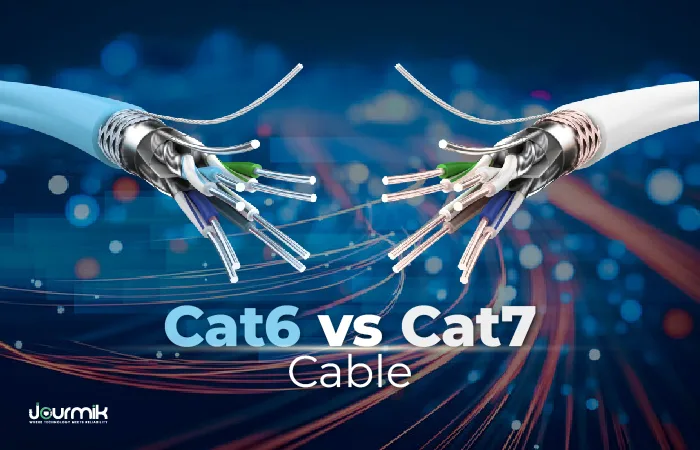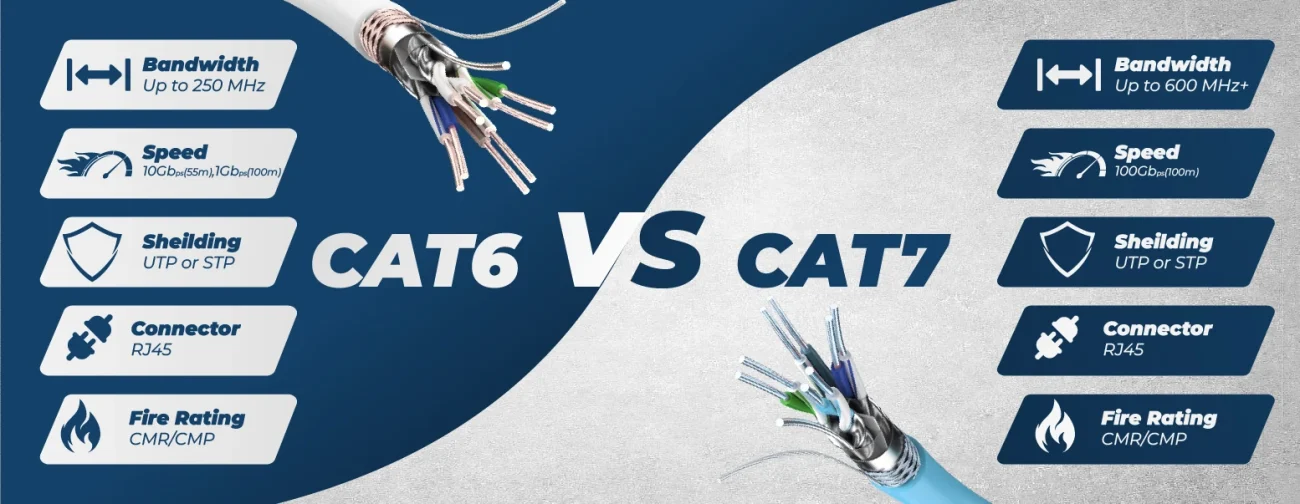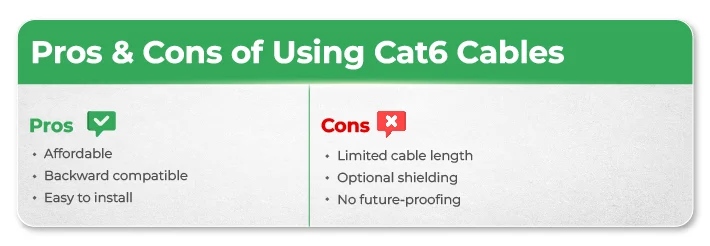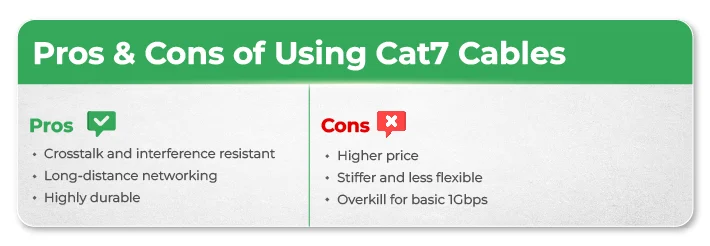Cat6 vs Cat7 Cable: Which Ethernet Cable is Right for You?

Imagine this: you’re in the middle of an intense online gaming session or streaming a 4K movie, and suddenly, your connection drops. Did you know that the culprit might not be your router or ISP, but the Ethernet cable quietly connecting your devices?
The choice between a Cat6 and Cat7 cable might seem minor, but the impact on your network’s speed, bandwidth, and overall performance. Selecting the wrong cable can lead to high costs, increased latency, or susceptibility to interference, leaving you frustrated and disconnected. Unsure which cable type you should use between Cat6 or Cat7, you need to understand their key differences, such as speed (up to 10 Gbps for Cat6 and beyond for Cat7), bandwidth capacity, and effective distance coverage.
Keep reading to learn why Cat6 vs Cat7 cables matters and how to choose the perfect cable for your specific needs.
Table of Contents
What is Cat6 Cable?
Cat6, or Category 6, is a standardized Ethernet cable, built with four twisted copper pairs and is designed to deliver reliable performance for speeds up to 10Gbps.. It’s a step up from Cat5e, offering better home and small office network performance.
Read More: Different between Cat5 and Cat6 cable
Key Specifications of Cat6
- Bandwidth: Up to 250 MHz, double that of Cat5e.
- Speed: 10Gbps up to 55 meters; 1Gbps up to 100 meters.
- Shielding: Available in unshielded (UTP) or shielded (STP) variants.
- Connector Type: Standard RJ45, ensuring Cat6 vs. Cat7 compatibility with most devices.
- Fire Rating: Typically meets basic safety standards like CMR or CMP.
What is Cat7 Cable?
Cat7, or Category 7, is a premium Ethernet cable designed for high-performance networking. Introduced to support 10Gbps over longer distances, it’s built with advanced shielding and a higher bandwidth capacity than its predecessors.
Key Specifications
- Bandwidth: Up to 600 MHz (some variants exceed this).
- Speed: 10Gbps up to 100 meters.
- Shielding: Fully shielded twisted pair (STP) with individual pair shielding and an overall braid.
- Connector Type: Typically RJ45, but also supports GG45 or TERA for specialized setups.
- Fire Rating: Often meets stringent standards for Cat6 vs. Cat7 fire rating.

Application and Uses of Cat6 and Cat7 Cables
Both cables have their own uses and applications based on their construction, speed, and interference resistance. Here, we’ll help you decide which Ethernet cable to use if you’re struggling to choose between them:
- Cat6 is used for setups with smart TVs and gaming consoles. While Cat7 for data centers handling massive traffic
- Cat6 cables are used in small offices or educational institutions needing reliable connectivity. Cat7 on the other hand is used in factories with electromagnetic interference. And it is also used for professional streaming setups
Pros and Cons of Cat6 vs Cat 7
Pros of Using Cat6 Cables
- Affordable and widely available at stores like Jourmik.com.
- Backward compatible with Cat5 and Cat5e devices.
- Decent interference resistance for typical indoor environments.
- Easy to install due to its flexibility.
Cons of Using Cat6 Cables
- Limited Cat6 vs. Cat7 cable length for 10Gbps (55 meters max).
- Optional shielding means it’s less effective against crosstalk in noisy areas.
- Not as future-proof as higher categories like Cat7.

Pros of Using Cat7 Cables
- Exceptional crosstalk and interference resistance due to superior shielding.
- Full 10Gbps for long distances, ideal for Cat6 vs. Cat7 for long-distance networking.
- Highly durable and built to last in tough conditions.
Cons of Using Cat7 Cables
- Higher price makes it less budget-friendly.
- Stiffer and less flexible, complicating installation.
- Overkill for basic 1Gbps or 2.5Gbps networks.

A side-by-side comparison of Cat6 vs. Cat7:
| Feature | Cat6 | Cat7 |
| Speed | 10Gbps (55m), 1Gbps (100m) | 10Gbps (100m) |
| Bandwidth | 250 MHz | 600 MHz |
| Shielding | Optional (UTP/STP) | Fully shielded (STP) |
| Max Length (10Gbps) | 55 meters | 100 meters |
| Cost | Lower | Higher |
| Best Use | Home, small offices | Data centers, industrial |
Performance Factors to Consider
Since we now differentiate these two cables, let’s examine some factors that decide their performance.
Distance Limitations
- Cat6 vs. Cat7 cable length: Cat6 limits 10Gbps to 55 meters; Cat7 extends it to 100 meters.
- Both handle 1Gbps up to 100 meters effortlessly.
Interference and Crosstalk
Interference and crosstalk between Cat6 and Cat7 are critical concerns. Unshielded Cat6 can pick up noise from nearby cables or devices, degrading performance. Cat7’s robust shielding keeps signals clean, even in chaotic settings.
Network Speed
- Cat6 vs. Cat7 for 1Gbps: Cat6 is plenty.
- Cat6 vs. Cat7 for 2.5Gbps: Cat6 still works well.
- Cat6 vs. Cat7 for 10Gbps: Cat7 is the better pick for reliability. For official standards for speed see the IEEE 802.3-2018 standard.
Future-Proofing
With 10GbE (10 Gigabit Ethernet) on the rise, the future-proofing debate between Cat6 and Cat7 leans toward Cat7. Higher bandwidth and shielding prepare it for tomorrow’s speeds, while Cat6 may soon lag behind.
Which Cable is Best for Your Network Needs?
Now that you know how they install, let’s determine which cable best suits your setup. Here’s a breakdown to guide your choice between Cat6 and Cat7.
Cat6 and Cat7 Based on Your Network’s Demands
Choosing between Cat6 and Cat7 depends on your needs. Cat6 handles 1Gbps or 2.5Gbps for basic tasks like streaming, while Cat7 excels at 10Gbps for heavy lifting, think data centers or high-performance gaming. Both Cat6 and Cat7 work for PoE, but Cat7 offers extra reliability over distance.
When to Use Cat6 for Home Networks
Cat6 is perfect for home network setups vs. Cat7. It supports 1Gbps, the standard for most homes and even 2.5Gbps, covering gaming, smart devices, and more. It’s affordable and easy to install, making it a top pick for residential use.
Read More: How to choose Cat6 cable

When to Use Cat7 for High-Performance Applications
Choose Cat7 for high-bandwidth applications. It’s built for 10Gbps in industrial use, educational institutions, or commercial use with many users. For Cat6 vs. Cat7 for gaming, pros might prefer Cat7’s low latency in competitive play.
Is Cat7 Worth the Investment for Home Users?
For most homes, Cat7 vs. Cat6 isn’t worth the extra cost. Cat6 meets typical needs, while Cat7’s power suits future 10Gbps plans or high-interference areas, otherwise, it’s overkill.
Scenarios Where Cat6 and Cat7 Are Both Viable Options
Both work in cases like PoE or Cat6 vs. Cat7 for long distances under 55 meters at 1Gbps. Cat6 saves cash; Cat7 adds durability. Pick based on budget and environment.
Conclusion
Choosing between Cat6 and Cat7 cables depends on your network’s needs. Cat6 is the budget-friendly champ for home networks, delivering reliable 1Gbps or 2.5Gbps speeds with easy installation, perfect for streaming, gaming, or casual use. Cat7, with its superior 10Gbps range up to 100 meters and robust shielding, shines for high-performance applications like data centers, industrial setups, or future-proofing.
The difference between Cat6 and Cat7 lies in speed, bandwidth (250 MHz vs. 600 MHz), and interference resistance, so your choice hinges on balancing cost, performance, and environment. Both are backward compatible, ensuring flexibility, but Cat7’s edge makes it the long-term winner as 10GbE grows.
In short, Cat6 suits most homes, while Cat7 powers demanding setups. Don’t guess; choose wisely. Are you ready to upgrade your network?
Explore our range of high-quality Cat6 cables at Joumik.com today!
FAQs
Can I Use Cat8 for Home Networking?
Yes, but it’s overkill. Cat8 is designed for data centers (25Gbps/40Gbps), far exceeding typical home needs (1Gbps/2.5Gbps). Stick to Cat6 or Cat7 unless future-proofing for extreme speeds.
Which Ethernet Cable is Right for My Business?
Assess speed, distance, and budget. Cat6 suits small offices (1Gbps), while Cat7 is better for larger setups (10Gbps) or interference-prone environments.
What’s the Maximum Length for Ethernet Cables?
Both Cat6 and Cat7 support 100 meters at 1Gbps. For 10Gbps, Cat6 maxes out at 55 meters, while Cat7 reaches 100 meters.
Are Shielded Cables Necessary for Home Use?
Not usually. Unshielded Cat6 (UTP) works fine for most homes. Shielded cables (STP) like Cat7 are better for noisy environments but overkill for typical residential use.
Is Cat7 Worth It for Gaming?
Casual gamers can use Cat6 (1Gbps). Competitive gamers may prefer Cat7 for 10Gbps and lower latency in high-performance setups.
Do Cat6 and Cat7 Support PoE?
Yes, both support Power over Ethernet (PoE). Cat7’s thicker construction offers slight durability advantages for long runs or powering devices like cameras.
